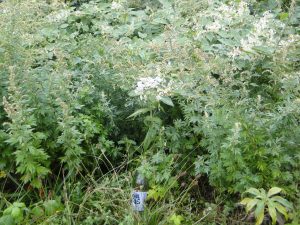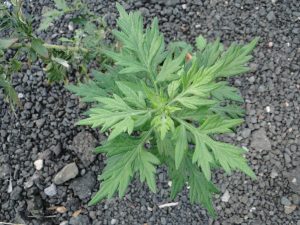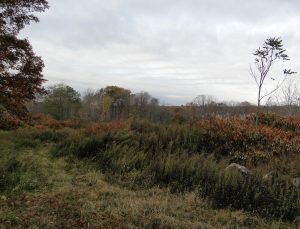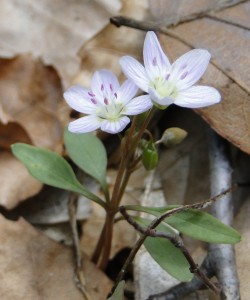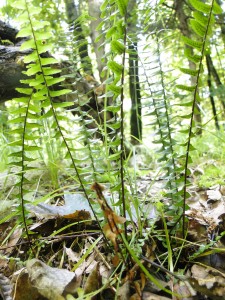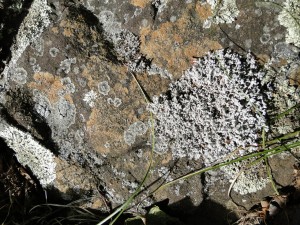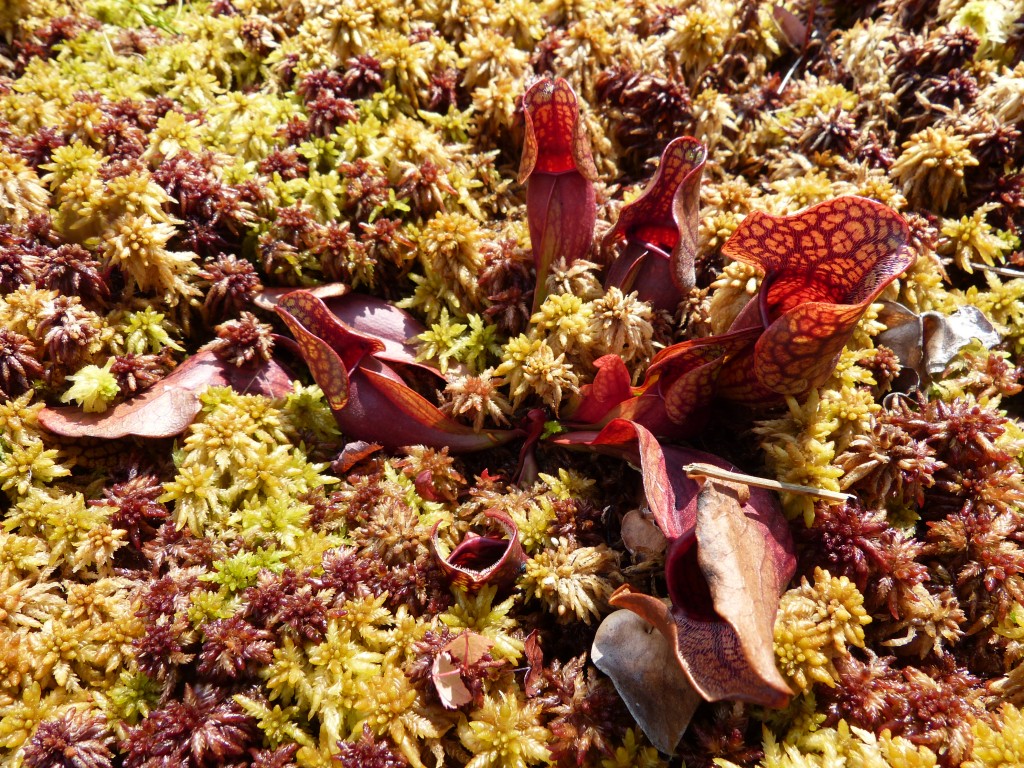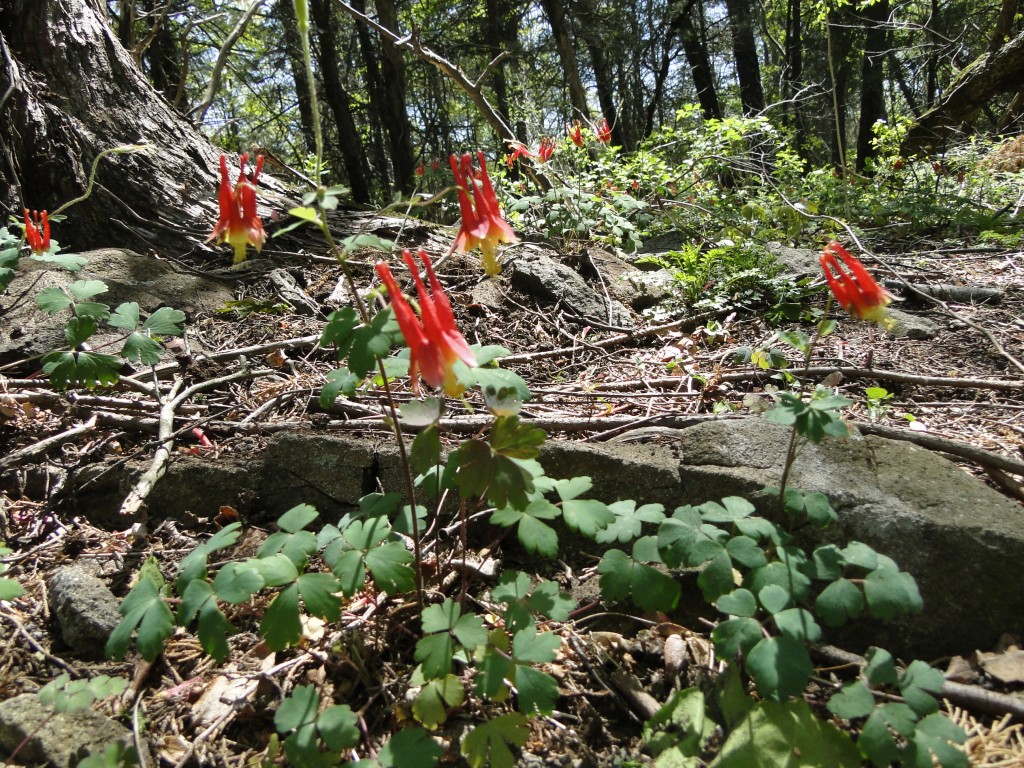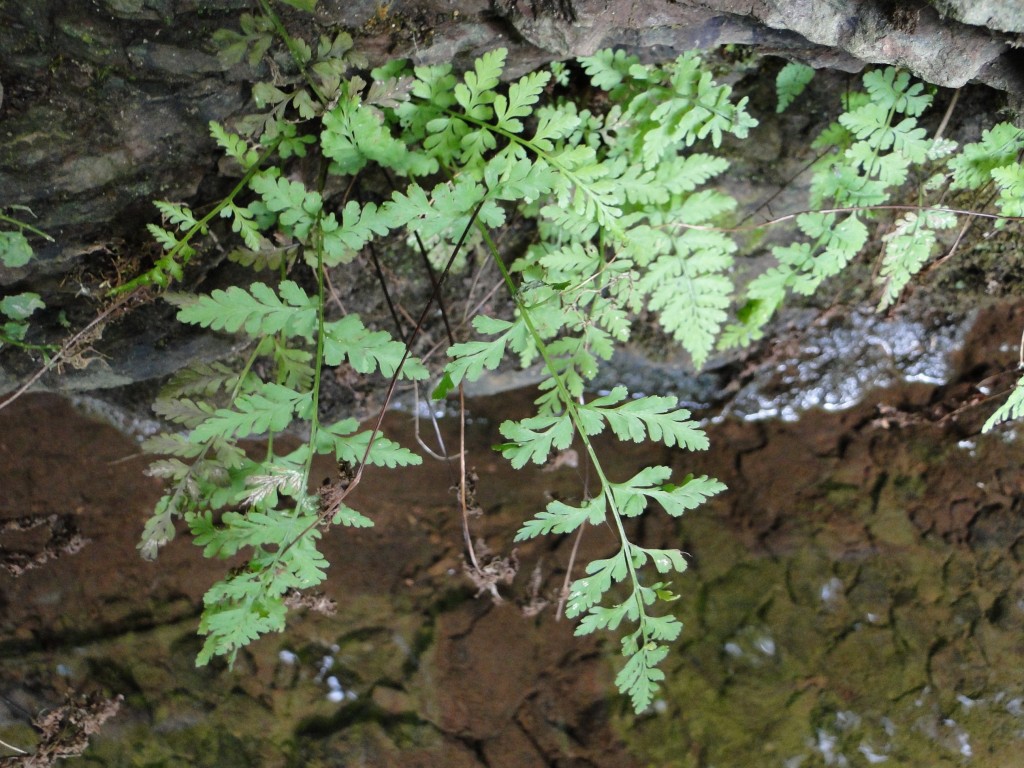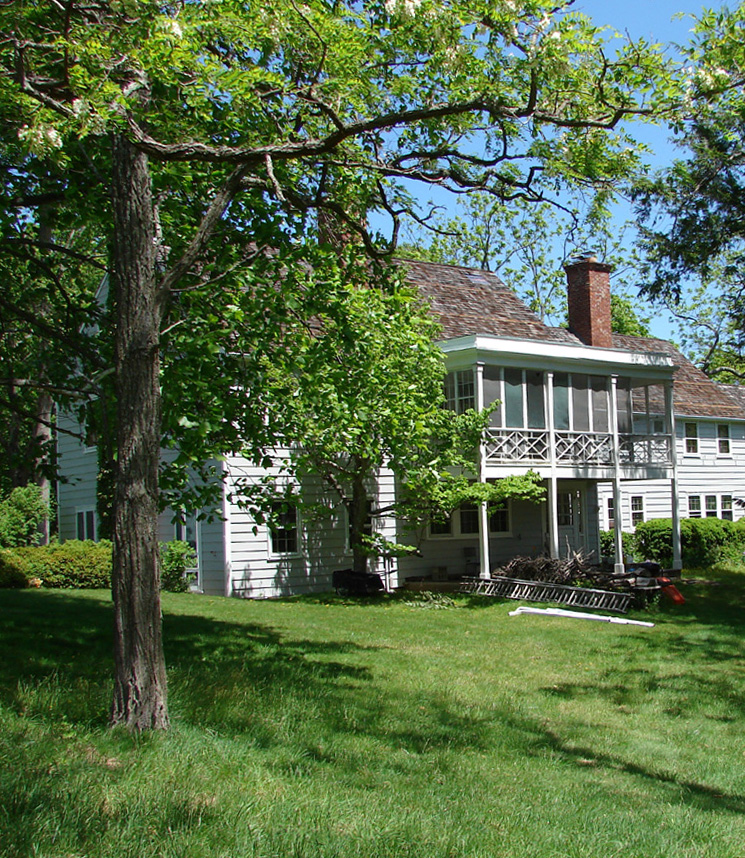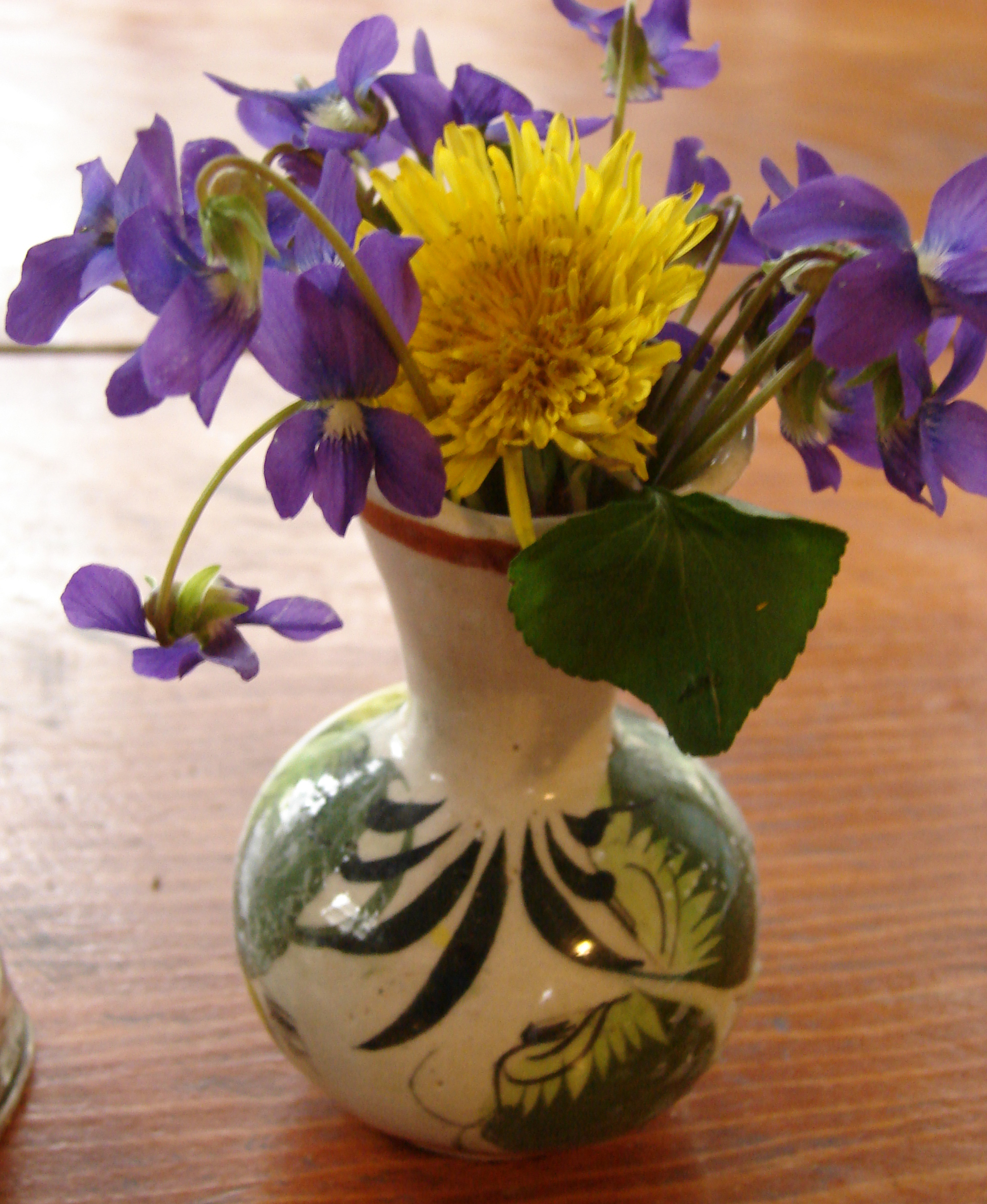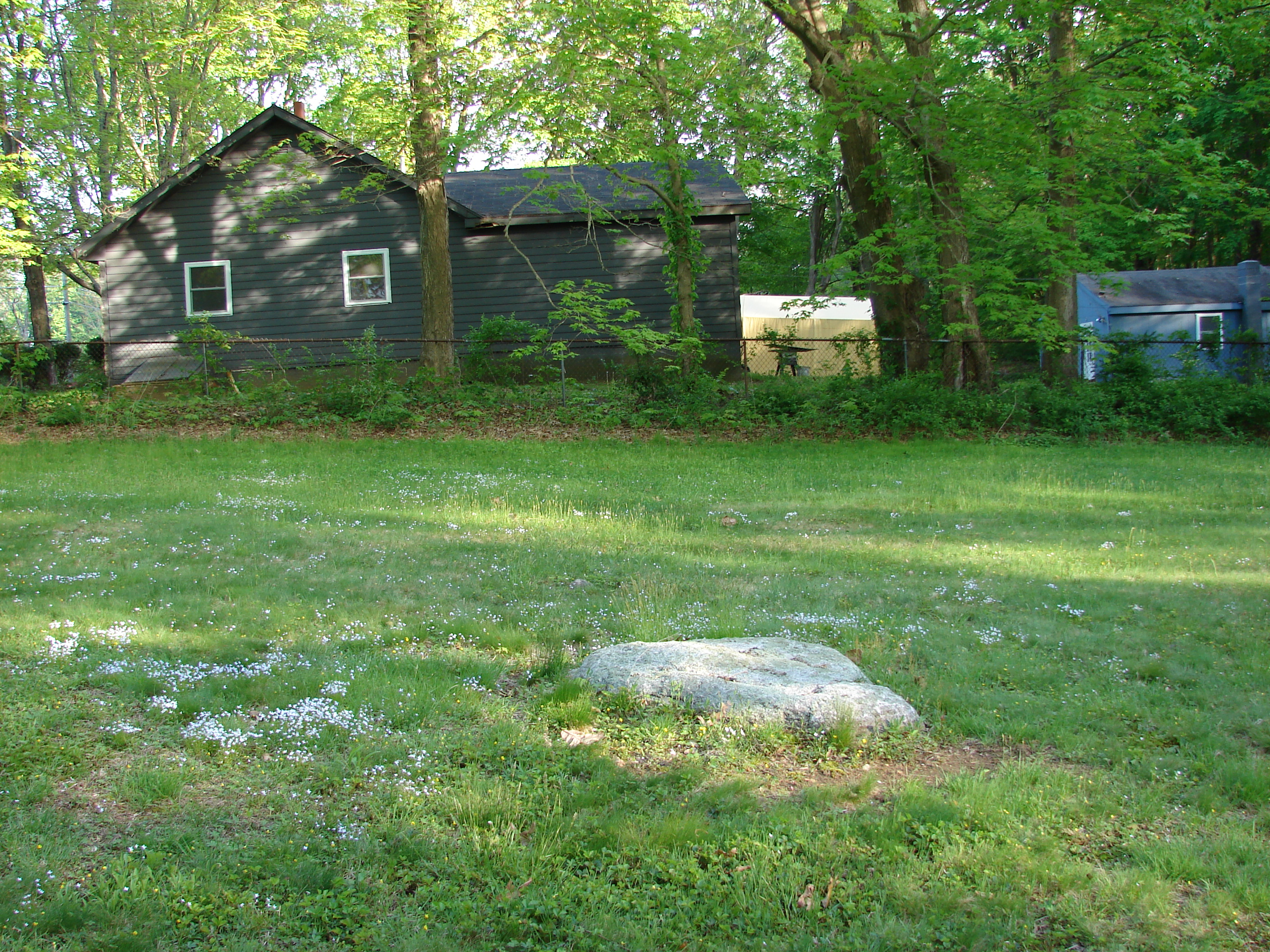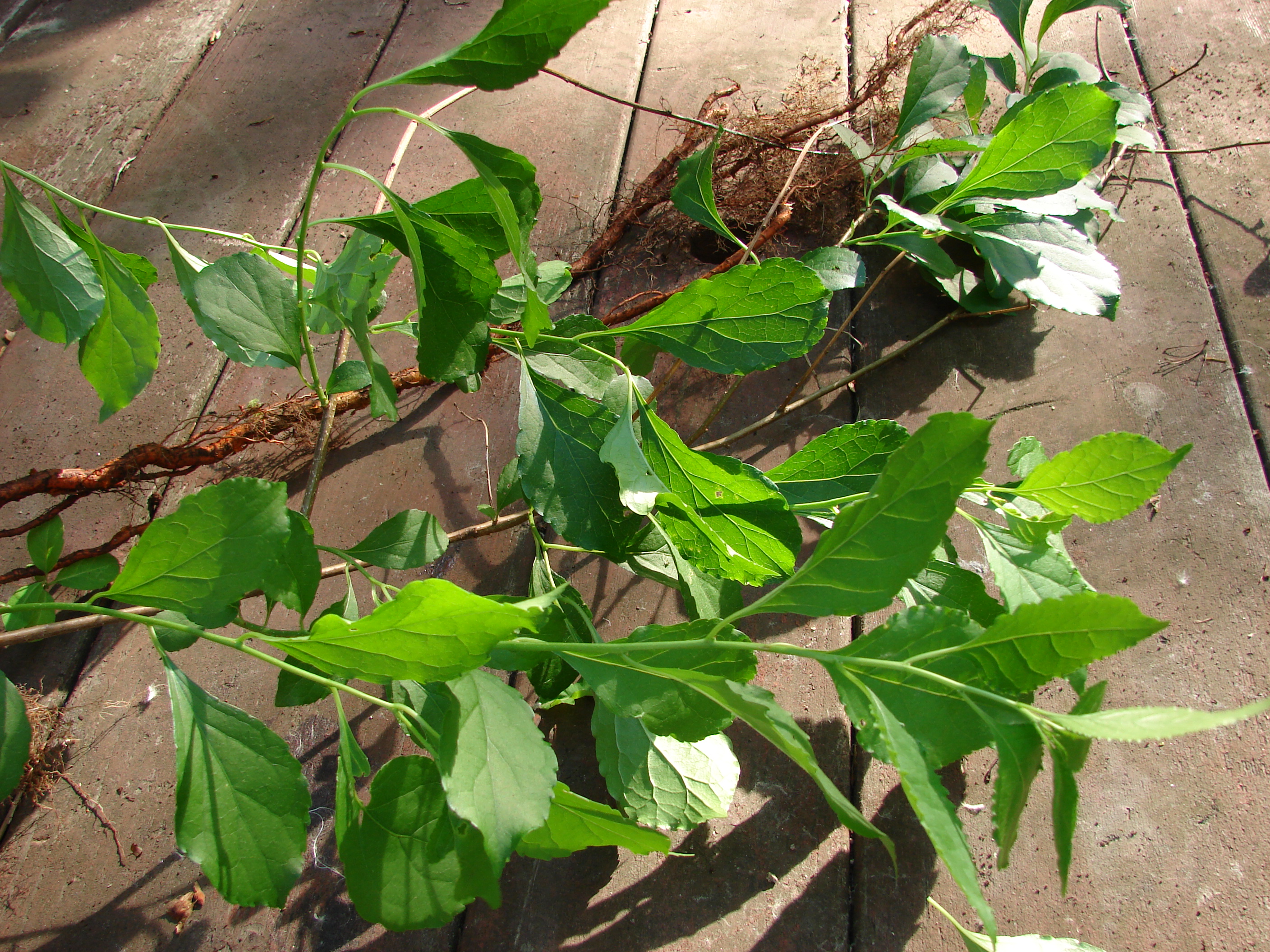Why we should proactively control Ailanthus altissima.
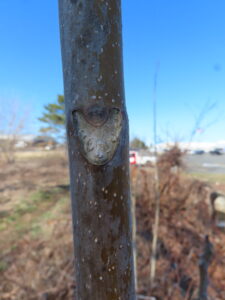
Early spring, before thicket vegetation in in full leaf, is a good time to locate sprouts and trees of “Tree of Heaven” (Ailanthus altissima) – if we know what they look like. Today, at a restoration site, I was tying blue ribbons on staghorn sumac (Rhus typhina), with exceptional wildlife habitat value. Pink ribbons were tied on young, invasive Ailanthus, which is remarkably like sumac, though unrelated. Ailanthus is not yet an abundant invasive in Connecticut, but it is a serious threat. Basal treatments of Ailanthus with triclopyr ester in oil are planned for mid-July. Blue stands for “save”, pink stands for “treat”. We do not want to treat the staghorn sumac accidentally!
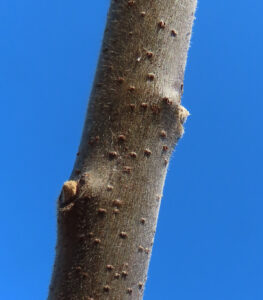
To tell them apart before leaf-out, use an obvious Ailanthus field mark: the huge leaf scars with numerous bundle scars. Staghorn sumac has a narrow U-shaped bud scar that wraps around a furry bud. Viewed from a distance, both have similar thick branches, but Ailanthus bark is smooth, whereas staghorn sumac has “velvet” on the thick, blunt, antler-like twigs, obvious in all seasons.
In summer young Ailanthus looks like a sumac on steroids, and when mature it resembles black walnut. It grows 80 to 100 feet tall, and its compound leaves have up to 40 leaflets.
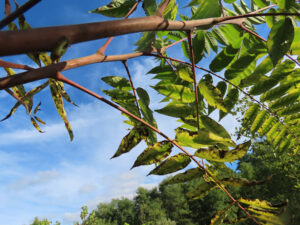
Each Ailanthus leaflet has smooth edges except for one or two snaggle teeth at the base, whereas sumac and walnut leaflets are serrated from tip to base. For more information on lookalikes, see:
https://extension.psu.edu/tree-of-heaven and
https://mortonarb.org/plant-and-protect/trees-and-plants/staghorn-sumac/.
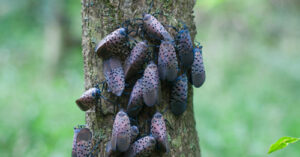
Why is proactive control of Ailanthus a priority? Foremost, Ailanthus fosters spotted lanternfly (Lycorma delicatula), a serious, polyphagous pest of vineyards, orchards, street trees, and many other woody plants. Both come from China. The lanternfly reaches high population densities, killing woody vines and saplings and damaging full-size trees. This opens up the landscape for colonization by Ailanthus, which requires high light levels to grow. Lanternfly nymphs can feed on a wide range of plants, but a 2020 study showed that nymphs that develop on Ailanthus grow more quickly and produce more offspring than those on other trees species, like maple and walnut. Fall lanternfly nymphs on Ailanthus were much more likely to lay their eggs before frost.
Ailanthus leaf tissue is also the source of the cytotoxins (quassinoids) that confer a repugnant taste that protects spotted lantern flies from birds and other predators. Birds that have experienced the foul-tasting nymphs will also avoid palatable nymphs that have fed on other plants. (It is unclear to what extent the quassinoids are also toxic.) Through social learning, this avoidance behavior hinders expansion of avian biological control, as explained in a 2024 article by Daniel Stroembon et al.
Ailanthus emits volatile attractants that attract spotted lanternflies like a magnet, sometimes by the thousands. Where lanternfly is well-established, in the mid-Atlantic states, Ailanthus trees are used by pest control firms to trap these pests, before killing them en masse. Spotted lanternfly is just beginning to reach Connecticut. Scattered early colonizers are likely to bypass an Ailanthus-free community. More aggressive control of Ailanthus altissima will slow down the spotted lanternfly invasion.
Without a doubt Ailanthus altissima meets Les Mehrhoff’s widely accepted definition of an invasive species: It has very high reproductive potential and is able to expand into natural areas and outcompete native plant species.
- It is a fast-growing, clonal tree, and an expanding patch can take over more than half-acre of habitat, outcompeting native tree and shrubs, in part by means of allelopathy. Ailanthus roots secrete chemicals that inhibit growth of other competing plants, some species more than others.
- It produces vast numbers of seeds. According to a 2007 dispersal study published in Plant Ecology, Ailanthus altissima “is able to disperse long distances [by wind] into fields and into mature forests and can reach canopy gaps and other suitable habitats at least 100 m from the forest edge. It is an effective disperser and can spread rapidly in fragmented landscapes where edges and other high light environments occur.”
- Water-borne seed dispersal is also important. Even in a truly urban setting, where wind-dispersed seeds would not reach farmland or natural forests, Ailanthus seeds wash into catch basins, and then into rivers, and floodwaters deposit the seeds on river levees. Throughout the US, its distribution follows river networks.
- This tree also excels at seedling establishment. Betty Smith got the science right in A Tree Grows in Brooklyn. Ailanthus can colonize cracks in pavements – or crevices in cliffs. I was dismayed to find an Ailanthus clone on the steep mountainside just west of Castle Craig, in Meriden. I also saw many on rip-rap Amtrak railroad embankments in Old Saybrook. It needs ample light, but not deep, fertile soil.
Ailanthus altissima is relatively easy to control but often overlooked, except for the mature female trees, which bear conspicuous masses of dark red flowers in late summer and early fall. Females are sold, bare-root, on-line. If money or volunteer resources are short, the priority should be removal of the female seed-producing trees. Trycera, Pathfinder and Garlon 4 are safe, systemic herbicides that can be purchased on-line and applied to the lower stem of Ailanthus suckers. They are all triclopyr esters, with an oil carrier, but only Trycera may be applied by volunteers and property owners without a pesticide applicator’s license in Connecticut, though not for pay. Mid-summer is the optimal time to apply, to minimize resprouting.
Per a 2023 article in Forestry and Wildlife by Nancy Loewenstein et al, basal oil application of trichlopyr ester is most useful “where the target tree or shrub density is moderate to low, manual labor is available, and dead standing trees and shrubs can be tolerated.” The method should be used only in low to moderate density invasive stands, to prevent changes to the soil microbe community, and impacts to non-target plants via root systems. Note that treatment of trees over five inches in diameter requires a modified “hack and squirt” method. (See Aces link to the Forestry and Wildlife article below for more information).
This invasive tree is an indirect economic threat as well as an ecological one. EDRR (Early Detection and Rapid Response) should be a high priority for Tree of Heaven. It would be helpful if land trust stewardship directors and town tree wardens could be alerted about Tree of Heaven (Ailanthus altissima) occurrences, so infestations can be nipped in the bud and further spread minimized. Spotted lanternfly sightings should be reported to CAES (The Connecticut Agricultural Station) using this link: Spotted Lanternfly – SLF (ct.gov).
Should male Ailanthus trees (which produce no seeds) be spared in urban areas or school yards? The answer is no, despite the fact that a mature Tree of Heaven blesses its neighborhood with shade, cooling, beauty, and air pollution filtration, like any large urban tree. Their scent, unpleasant to humans, is a magnet for stray lantern flies, and will attract stray dispersing spotted lanternflies. Other urban trees will soon be infested as well. These male trees will bear no seeds, but they can be productive lanternfly nurseries, yielding thousands of vile-tasting nymphs. As discussed in the 2024 Stroembon article, local birds will learn to avoid spotted lanternflies altogether, and such aversion does spread through social learning. This will reduce the potential for effective avian biological control of palatable – and nutritious – lanternfly populations in orchards, preserves, and treed residential neighborhoods.
Landenberger, Rick E. Nathan L. Kota , and James B. McGraw. 2007. Seed dispersal of the non-native invasive tree Ailanthus altissima into contrasting environments. Plant Ecology (192):5–70.
Loewenstein, Nancy Stephen Enloe, Ken Kelley, and Beau Brodbe. July 21, 2023. Basal Bark Herbicide Treatment for Invasive Plants in Pastures, Natural Areas & Forests. https://www.aces.edu/blog/topics/forestry-wildlife/basal-bark-herbicide-treatment-for-invasive-plants-in-pastures-natural-areas-forests.
Stroembon, Daniel, A. Crocker, A. Gray, A. Sands, G. Tulevich, K Ward, Swati Pandey. February 2024. Modelling the emergence of social-bird biological controls to mitigate invasions of the spotted lanternfly and similar invasive pests. Royal Society Open Science. 11(2) https://royalsocietypublishing.org/doi/10.1098/rsos.231671
Uyi, Osariyekemwen, J. Keller, A. Johnson, B. Walsch, D. Long, and K. Hoover. 2021. Spotted Lanternfly can complete development and reproduce without access to the preferred host, Ailanthus altissima. Environmental Entomology nvaa 083.
http://doi-org/10.1093/ee/nvaa083.
By Sigrun Gadwa, Carya Ecological Services, LLC www.caryaecological.com 3-16-24
